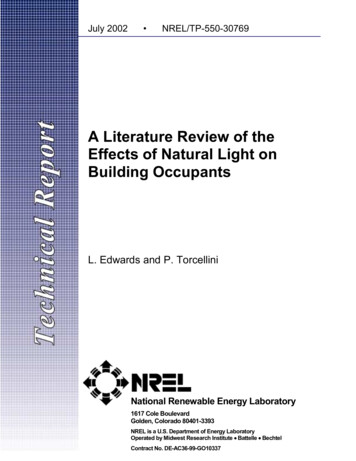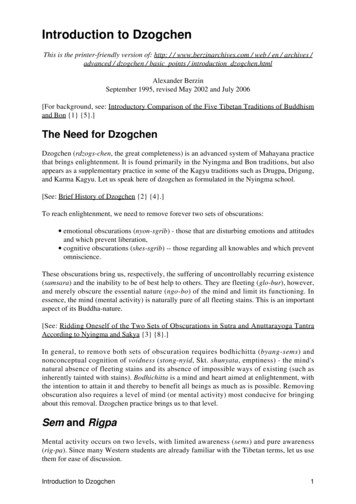
Transcription
The science of lightP. Ewart
Oxford Physics: Second Year,Optics Lecture notes: On web siteNB outline notes! Textbooks:Hecht, OpticsKlein and Furtak, OpticsLipson, Lipson and Lipson, Optical PhysicsBrooker, Modern Classical Optics Problems: Material for four tutorials plus pastFinals papers A2 Practical Course: Manuscripts and Experience
Oxford Physics: Second Year,OpticsStructure of the Course1.Geometrical Optics2.Physical Optics (Interference)Diffraction Theory (Scalar)Fourier Theory3.Analysis of light (Interferometers)Diffraction GratingsMichelson (Fourier Transform)Fabry-Perot4.Polarization of light (Vector)
s10-7 T 107 K; e- 109 eV; superconductorQuantumOpticsPhotonics
Oxford Physics: Second Year,OpticsAstronomical observatory, Hawaii, 4200m above sea level.
Oxford Physics: Second Year,OpticsMulti-segmentObjective mirror,Keck Obsevatory
Oxford Physics: Second Year,OpticsHubble Space Telescope, HST,In orbit
Oxford Physics: Second Year,HST Deep FieldOldest objectsin the Universe:13 billion yearsOptics
Oxford Physics: Second Year,OpticsHST Image: Gravitational lensing
Oxford Physics: Second Year,SEM Image:Insect headOptics
Oxford Physics: Second Year,OpticsCoherent Light:Laser physics:Holography,TelecommunicationsQuantum opticsQuantum computingUltra-cold atomsLaser nuclear ignitionMedical applicationsEngineeringChemistryEnvironmental sensingMetrology etc.!
Oxford Physics: Second Year,OpticsCD/DVD Player: optical tracking assembly
Oxford Physics: Second Year,OpticsOptics in Physics Astronomy and CosmologyMicroscopySpectroscopy and Atomic TheoryQuantum TheoryRelativity TheoryLasers
Oxford Physics: Second Year,OpticsGeometrical Optics Ignores wave nature of light Basic technology for optical instruments Fermat’s principle:“Light propagating between two pointsfollows a path, or paths,for which the time taken is an extremum”
Oxford Physics: Second Year,OpticsRay tracing - revisionFocal pointaxisFocal point
Oxford Physics: Second Year,OpticsSimple magnifieraMagnifier:angular magnification b/aEyepiece ofTelescopes,Microscopes etc.Objectat near pointbVirtual imageat near pointShort focal lengthlens
Oxford Physics: Second Year,OpticsP1Thick lens orcompound lensFirstPrincipalPlaneLocation ofequivalent thin lensBackFocalPlane
Oxford Physics: Second Year,OpticsThick lens orcompound lensFrontFocalPlaneP2SecondPrincipalPlane
Oxford Physics: Second Year,OpticsTelephoto lensFocalPlanePrincipalPlanefTEquivalent thin lens
Oxford Physics: Second Year,OpticsWide angle lensPrincipal FocalPlanePlanefW
Oxford Physics: Second Year,OpticsAstronomical TelescopefOfEbangular magnification b/a fo/fE
Oxford Physics: Second Year,OpticsGalilean Telescopeangular magnification b/a fo/fE
Oxford Physics: Second Year,OpticsNewtonian Telescopefoangularmagnification b/a fo/fEfEb
Oxford Physics: Second Year,OpticsThe compound microscopeObjective magnification v/uEyepiece magnifies real image of object
Oxford Physics: Second Year,OpticsWhat size to make the lenses?Aperture stopImage of objectivein eyepieceEye piece pupil sizeObjective: Image in eye-piece pupil size
Oxford Physics: Second Year,(a)Optics(b)Field stop
Oxford Physics: Second Year,OpticsILLUMINATION OFOPTICAL INSTRUMENTSf/no. : focal lengthdiameter
Oxford Physics: Second Year,OpticsLecture 2: Waves and Diffraction InterferenceAnalytical methodPhasor methodDiffraction at 2-D apertures
Oxford Physics: Second Year,OpticsT uut, xTimeor distanceaxist,zPhase change of 2p
Oxford Physics: Second Year,OpticsPr1r2qddsinqD
Phasor diagramOpticsImaginaryOxford Physics: Second Year,u Real
Oxford Physics: Second Year,OpticsPhasor diagram for 2-slit interferenceup / uuo/ror uuoo/rr
Oxford Physics: Second Year,OpticsDiffraction from a single slit a/2ydyqr ysinqrysinq-a/2DP
Oxford Physics: Second Year,OpticsIntensity pattern fromdiffraction at single slit1.00.80.62sinc (b)0.40.20.0-10 p p-5 p0bp5 p10 p
Oxford Physics: Second Year,OpticsP a/2q-a/2rasinqD
Oxford Physics: Second Year,Phasors and resultantat different angles qOpticsq 0RP RO/q 0RP
Oxford Physics: Second Year,Optics / RR sin /2RPR
Oxford Physics: Second Year,OpticsPhasor arc tofirst minimumPhasor arc tosecond minimum
Oxford Physics: Second Year,Opticsyxqz
Diffraction from a rectangular aperture
Oxford Physics: Second Year,OpticsDiffraction pattern from circular apertureIntensityyxPoint Spread Function
Diffraction from a circular aperture
Diffraction from circular apertures
Oxford Physics: Second Year,OpticsDustpatternDiffractionpatternBasis of particle sizing instruments
Oxford Physics: Second Year,OpticsLecture 3: Diffraction theoryand wave propagation Fraunhofer diffraction Huygens-Fresnel theory ofwave propagation Fresnel-Kirchoff diffractionintegral
Oxford Physics: Second Year,Opticsyxqz
Diffraction from a circular aperture
Oxford Physics: Second Year,OpticsFraunhofer DiffractionA diffraction pattern for which thephase of the light at theobservation point is alinear function of the positionfor all points in the diffractingaperture is Fraunhofer diffractionHow linear is linear?
Oxford Physics: Second Year,OpticsrRsourcer / 0raRaRRdiffractingapertureobservingpoint
Oxford Physics: Second Year,OpticsFraunhofer DiffractionA diffraction pattern formed in the imageplane of an optical system isFraunhofer diffraction
Oxford Physics: Second Year,OpticsPAOBfC
Oxford Physics: Second Year,OpticsuvEquivalent lenssystemDiffractedwavesimagedFraunhofer diffraction: in image plane of system
Oxford Physics: Second Year,Optics(a)OP(b)OPEquivalent lens system:Fraunhofer diffraction is independent of aperture position
Oxford Physics: Second Year,OpticsFresnel’s Theory of wave propagation
Oxford Physics: Second Year,OpticsdSnr-zP0zPlane wavesurfaceunobstructedHuygens secondary sources on wavefront at -zradiate to point P on new wavefront at z 0
Oxford Physics: Second Year,OpticsrrnnrnrnPqqConstruction of elements of equal area on wavefront
Oxford Physics: Second Year,OpticsrrppRpRp(q /2)(q /2)qqFirst Half Period ZoneResultant, Rp, represents amplitude from 1st HPZ
Oxford Physics: Second Year, /2rpOpticsPhase difference of /2at edge of 1st HPZqPOq
Oxford Physics: Second Year,OpticsRpAs n a infinity resultant a ½ diameter of 1st HPZ
Oxford Physics: Second Year,OpticsFresnel-Kirchoff diffraction integrali uo dSikrup (n, r ) e r
Oxford Physics: Second Year,Babinet’s PrincipleOptics
Oxford Physics: Second Year,OpticsLectures 1 - 3: The story so far Geometrical opticsNo wave effects Scalar diffraction theory:Analytical methodsPhasor methods Fresnel-Kirchoff diffraction integral:propagation of plane waves
Oxford Physics: Second Year,Joseph Fraunhofer(1787 - 1826)Phase at observation islinear function of positionin aperture: k sinq yOpticsAugustin Fresnel(1788 - 1827)up Gustav Robert Kirchhoff(1824 –1887)i uo dSikr (n,r)e rFresnel-Kirchoff Diffraction Integral
Oxford Physics: Second Year,OpticsLecture 4: Fourier methods Fraunhofer diffraction as aFourier transform Convolution theorem –solving difficult diffraction problems Useful Fourier transformsand convolutions
Oxford Physics: Second Year,OpticsFresnel-Kirchoff diffraction integral:iuo dSikrup (n.r )e rSimplifies to: u p A( b ) a u ( x)e dxibx whereb ksinqNote: A(b) is the Fourier transform of u(x)The Fraunhofer diffraction pattern is the Fourier transformof the amplitude function in the diffracting aperture
Oxford Physics: Second Year,OpticsThe Convolution function:h( x ) f ( x ) g ( x ) f ( x' ).g ( x x' ).dx' The Convolution Theorem:The Fourier transform, F.T., of f(x) is F(b)F.T., of g(x) is G(b)F.T., of h(x) is H(b)H(b) F(b).G(b)The Fourier transform of a convolution of f and gis the product of the Fourier transforms of f and g
Oxford Physics: Second Year,OpticsTMonochromaticWave.bo p/TFourierTransformb
Oxford Physics: Second Year, -functionOpticsVV(x)xoFourier transformPower spectrumV(b)V(b)* V2 constantxV(b)bb
Oxford Physics: Second Year,OpticsComb of -functionsV(x)xSFourier transformxV(b)b
Oxford Physics: Second Year,OpticsConstructing a double slit function by convolutiong(x-x’ )h(x)f(x)
Oxford Physics: Second Year,OpticsTriangle as a convolution of two “top-hat” functionsg(x-x’ )f(x)h(x)This is a self-convolution or Autocorrelation function
Oxford Physics: Second Year,Optics Heat transfer theory:- greenhouse effect Fourier series Fourier synthesis and analysis Fourier transform as analysisJoseph Fourier (1768 –1830)
Oxford Physics: Second Year,OpticsLecture 6: Theory of imaging Fourier methods in optics Abbé theory of imaging Resolution of microscopes Optical image processing Diffraction limited imaging
Oxford Physics: Second Year,OpticsFresnel-Kirchoff diffraction integral:iuo dSikrup (n.r )e rSimplifies to: u p A( b ) a u ( x)e dxibx whereb ksinqNote: A(b) is the Fourier transform of u(x)The Fraunhofer diffraction pattern is the Fourier transformof the amplitude function in the diffracting aperture
Ernst Abbé (1840 -1905)
Oxford Physics: Second Year,OpticsFourier planed’daqv(x)u(x)ufvD
Oxford Physics: Second Year,OpticsThe compound microscopeObjective magnification v/uEyepiece magnifies real image of object
Diffracted orders from high spatial frequencies missthe objective lensqmax defines the numerical aperture and resolutionSo high spatial frequencies aremissing from the image.
Oxford Physics: Second Year,FourierplaneImageplaneOpticsImage processing
Oxford Physics: Second Year,OpticsOptical simulation of“X-Ray diffraction”(a) and (b) show objects:double helixat different angle of viewaba’b’Diffraction patterns of(a) and (b) observed inFourier planeComputer performsInverse Fourier transformTo find object “shape”
Oxford Physics: Second Year,OpticsPIV particle image velocimetry Two images recordedin short time interval Each moving particle givestwo point images Coherent illuminationof small area produces“Young’s” fringes inFourier plane of a lens CCD camera recordsfringe system –input to computerto calculate velocity vector
Oxford Physics: Second Year,OpticsPIV particle image velocimetry
Oxford Physics: Second Year,Opticsamplitude objectphase objectFourier planed’daqv(x)u(x)ufvD
Oxford Physics: Second Year,OpticsSchlieren rceCollimatingLensImagingLensKnifeEdgeImagePlane
Schleiren photography in i.c.engineSparkplugSchlieren film of autoignitionCourtesy of Prof CWG SheppardUniversity of Leeds
Oxford Physics: Second Year,OpticsDiffraction pattern from circular apertureIntensityyxPoint Spread Function, PSF
Oxford Physics: Second Year,OpticsLecture 7: Optical instruments andFringe localisation Interference fringes What types of fringe? Where are fringes located? Interferometers
Oxford Physics: Second Year,OpticsYoung’s slitsnon-localisedfringesPlanewaves
OpticstoPlanewavesDiffraction grating8Oxford Physics: Second Year,ZqqfFringes localised at infinity: Fraunhofer
Oxford Physics: Second Year,OpticsP’Wedgedreflecting surfacesPPointsourceO
Oxford Physics: Second Year,P’OpticsPOqq’Parallelreflecting surfacesPointsource
Oxford Physics: Second Year,OpticsWedgedReflecting surfacesP’R’PRExtended sourceSO
Oxford Physics: Second Extendedsource2t xpath difference xcosaa2t xcircular fringeconstant a
Oxford Physics: Second Year,OpticsSummary: fringe type and lNon-localisedEqual thicknessNon-localisedEqual inclinationLocalised in plane Localised at infinityof WedgeEqual thicknessEqual inclination
Microscopes etc. Oxford Physics: Second Year, Optics. Oxford Physics: Second Year, Optics P 1 First Principal Plane Back Focal Plane Location of equivalent thin lens . University of Leeds Spark plug. Oxford Physics: Second Year, Optics Intensity y x Diffraction pattern from circular aperture











